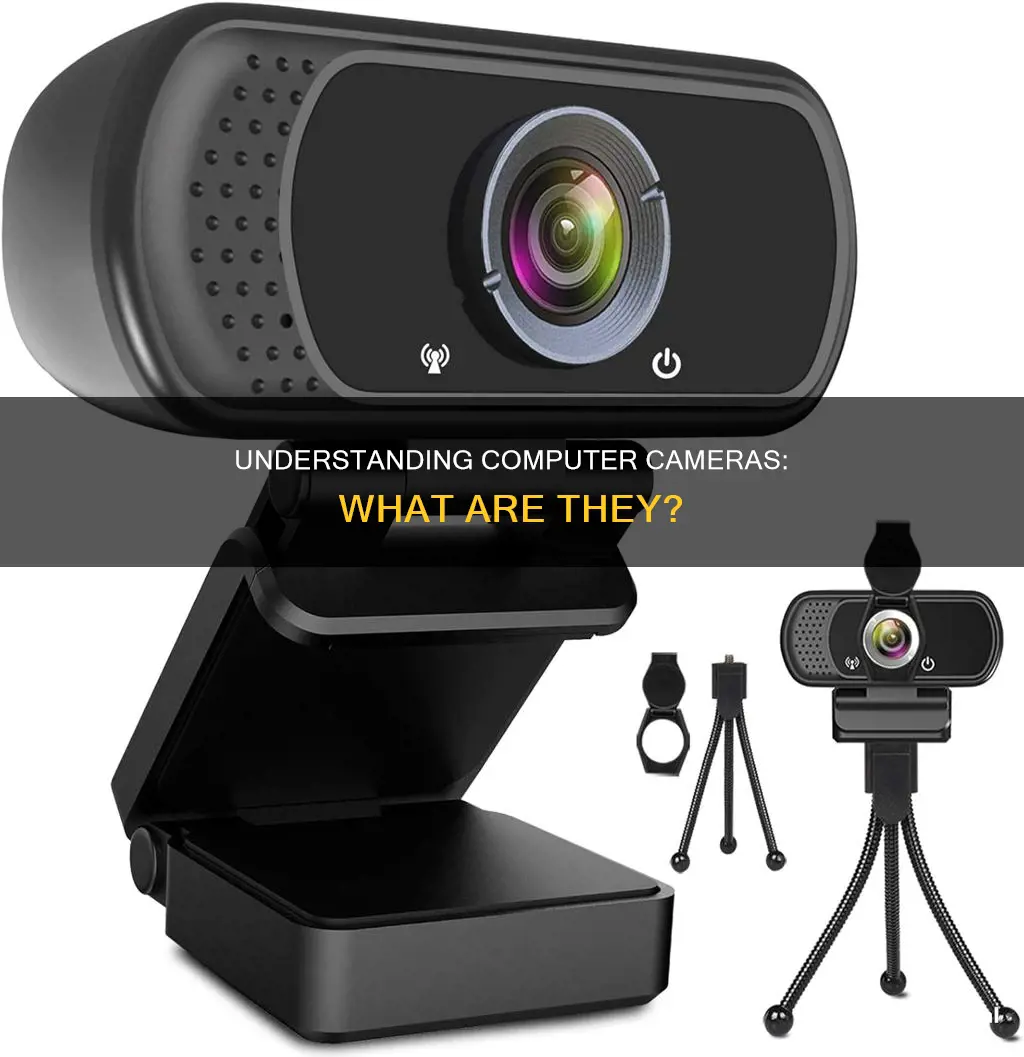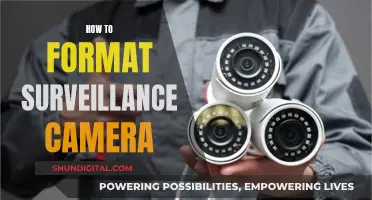
A webcam is a digital video camera connected to a computer or computer network, typically via USB or wireless protocols. They are used for video conferencing, online learning, video broadcasting, and security surveillance. Webcams can be built into computers or be standalone devices, and usually have a modest resolution of 720p or 1080p, although 4K models are available. They are often equipped with a microphone, but users may opt for headphones to improve audio quality.
| Characteristics | Values |
|---|---|
| Type | Webcam, Network Camera, IP Camera |
| Connection | Wired (USB, FireWire, Serial Port), Wireless |
| Use | Video Calling, Video Conferencing, Online Learning, Security Surveillance, Social Video Recording, Video Broadcasting, Computer Vision |
| Image Quality | Varies, can be lower than other camera models |
| Features | Motion Sensing, Image Archiving, Automation, Custom Coding |
| Flexibility | Can be built-in or external |
What You'll Learn
- Webcam types: integrated, wired, wireless, network, and IP cameras
- Webcam purpose: video calling, online meetings, web conferencing, online learning
- Webcam function: capturing light, converting light into digital information
- Webcam privacy: protecting your webcam from hackers
- Webcam applications: security, video calling, video broadcasting, computer vision

Webcam types: integrated, wired, wireless, network, and IP cameras
Webcams can be integrated into a computer or exist as separate devices, and they can connect to a computer or network in a variety of ways. Here are some of the most common webcam types:
Integrated Webcams
Some computers, laptops, and monitors come with integrated webcams, which are built directly into the device. These webcams are convenient and space-saving, as they don't require any additional setup or hardware. However, their image and video quality may be more limited compared to external webcams.
Wired Webcams
Wired webcams connect to a computer or device using a cable, usually USB or Ethernet. They are a reliable choice as they don't rely on a stable Wi-Fi connection and often provide better image quality than wireless webcams. They are commonly used for video conferencing, streaming, and gaming.
Wireless Webcams
Wireless webcams, on the other hand, connect to a device or network using Wi-Fi or Bluetooth. They offer more flexibility in terms of placement since they aren't tethered to a cable. However, they may be more susceptible to connection issues and interference. Wireless webcams are often used in situations where running cables is impractical or undesirable.
Network and IP Cameras
Network cameras, also known as IP (Internet Protocol) cameras, are a type of digital video camera commonly used for surveillance. They connect directly to a network, sending and receiving footage over the internet or a local area network (LAN). IP cameras can be wired or wireless and often offer advanced features such as pan-tilt-zoom capabilities, motion detection, and cloud storage. They are widely used in homes, businesses, and public spaces for security and monitoring purposes.
The Craft of Camera Bag Making
You may want to see also

Webcam purpose: video calling, online meetings, web conferencing, online learning
A webcam is a type of camera designed for video calling, online meetings, web conferencing, and online learning. Webcams are often used in conjunction with video conferencing software such as Zoom, Skype, Microsoft Teams, and Google Meet. They can also be used for streaming and content creation.
When choosing a webcam, it is important to consider the resolution, frame rate, field of view, microphone quality, and compatibility with video conferencing platforms. Most webcams use a standard USB connection and are compatible with both PCs and Macs. However, it is important to check if any additional software or drivers are required for the webcam to function properly.
Some features to look for in a webcam include:
- High-resolution video quality (1080p or 4K)
- Wide field of view (70-90 degrees)
- Strong low-light performance
- Noise-canceling microphone
- Adjustable stand or clip
- Dell Pro 2K Webcam: This webcam offers crisp image quality and clever software that keeps the user centered in the frame. It works well with both Mac and PC.
- Opal Tadpole: A small and portable webcam that offers quality video without taking up too much space. It also has a built-in mute function for the onboard mic.
- Logitech C920x HD Pro Webcam: This webcam delivers full HD 1080p video quality and clear stereo audio. It is compatible with various video conferencing platforms and features HD light correction.
- NexiGo N60 1080P Webcam: This webcam has a built-in microphone, adjustable field of view, software control, and a privacy cover. It is plug-and-play and compatible with Zoom, Skype, and Teams.
- Logitech Brio 4K Webcam: A feature-rich webcam offering ultra 4K HD video calling, noise-canceling microphone, HD auto-light correction, and a wide field of view. It is compatible with Microsoft Teams, Zoom, and Google Voice.
- Insta360 Link: This webcam offers 4K resolution, quick installation, DSLR-like autofocus, and AI-powered tracking features such as facial tracking and hand gestures for zooming. It is an excellent choice for business professionals, content creators, and educators.
Off-Brand Camera Batteries: Overheating Risk?
You may want to see also

Webcam function: capturing light, converting light into digital information
A webcam is a digital camera connected to a computer to stream live video in real-time. It is either integrated into the computer or connected via a USB cable or wirelessly. Webcams are used for a variety of functions, most commonly for online meetings, web conferencing, and online learning.
Webcams work by capturing light through their lens. The lens focuses the incoming light onto an image sensor, which is typically a charge-coupled device (CCD) or a complementary metal-oxide-semiconductor (CMOS) sensor. The image sensor is made up of millions of tiny light-sensitive pixels that collect and divide the incoming light into pixels. Each pixel on the sensor measures the intensity of the incoming light and converts it into an electrical charge. This process is known as the photovoltaic effect.
The electrical charges generated by the image sensor are then processed by the camera's electronics to create a digital representation of the captured image. This involves converting the light information into numerical language, known as binary code. This binary code can then be transferred across a network, such as the internet, to a receiving computer. The receiving computer then reverse engineers the process to convert the code back into pixels, which are displayed on a computer screen.
In addition to capturing and converting light, webcams also have other functions. They can be used to capture still images, although the quality may not always be the best. Webcams also have built-in microphones, allowing for audio capture along with the video. Some webcams also have infrared capabilities, enabling them to capture images in low-light conditions or even complete darkness.
Overall, the function of a webcam revolves around capturing light, converting it into digital information, and transmitting it to another device for display. This process has revolutionized the way we communicate and interact with others through online meetings, video conferencing, and remote learning.
HDR Mode: Moto G Camera's Dynamic Range Boost
You may want to see also

Webcam privacy: protecting your webcam from hackers
Webcam hacking, or "camfecting", is a serious threat to your privacy and security. It occurs when an unauthorized user accesses your webcam without your knowledge or consent, allowing them to spy on you, record footage, and even extort you. Here are some measures you can take to protect your webcam from hackers:
Keep Your Computer Secure
- Use antivirus software: Antivirus software detects and removes malware that hackers use to access your webcam. Pay attention to any alerts from your antivirus software and take appropriate action.
- Keep your computer updated: Regularly update your operating system and software to patch vulnerabilities that hackers could exploit. Enable automatic updates if available.
- Avoid downloading random files: Do not download programs from advertisements or open attachments in unexpected emails, as they may contain malware.
- Be cautious of suspicious emails: Delete emails claiming that your webcam has been hacked and demanding ransom. Instead, run a full scan with your antivirus software to ensure your computer is safe.
Restrict Permissions to Your Webcam
- Review and adjust privacy settings: In your device settings, control which apps can access your webcam and turn off access for apps you don't use.
- Disable webcam access: If you rarely use your webcam, you can disable it entirely in your device settings.
Protect Your Webcam Physically
- Unplug your webcam: If your webcam is not plugged in, it cannot be hacked. Keep your webcam unplugged when not in use.
- Cover your webcam: Use electrical tape, a sticker, or a webcam cover to block the camera's view. This prevents spying even if your webcam is accessed by a hacker.
- Turn off your device: When engaging in sensitive activities, turn off your computer or close your laptop to ensure the webcam cannot be accessed.
Additional Tips
- Beware of indicator lights: The indicator light may not always be a reliable sign that your webcam is active. Hackers can sometimes bypass or disable the light.
- Monitor battery drain: Camhacking software can drain your battery quickly by running background apps.
- Use a virtual private network (VPN): A VPN encrypts your network connection, concealing your identity and protecting your privacy when using public Wi-Fi.
- Install security software: Use reputable security software, such as Norton 360 Deluxe, to safeguard your device against viruses, spyware, and other malware.
Ohio Camera Tickets: What Happens When You Don't Pay?
You may want to see also

Webcam applications: security, video calling, video broadcasting, computer vision
Webcams are now a common feature on computers, laptops, and tablets. They can be used for a variety of applications, including security, video calling, video broadcasting, and computer vision.
Security
IP Cameras are commonly used for surveillance and security. Unlike analogue CCTV cameras, they don't require a local recording device, just a local area network. Most IP cameras are webcams, but the term usually applies to those that can be directly accessed over a network connection.
IP cameras can be used for home security, often featuring motion detection and night vision capabilities. They can be programmed to detect specific events, such as a human crossing a line or an object being stolen. Footage can be stored locally or via a cloud service.
Video Calling
Webcams are now a standard feature for video calling, whether for business or personal use. Video calling software often includes features such as background blurring, lighting adjustments, and noise reduction to improve the quality of the call.
Video Broadcasting
Webcams are also used for live streaming and video broadcasting, particularly by content creators and gamers. Features such as picture-in-picture, streaming to multiple platforms, and video effects are common.
Computer Vision
Computer vision uses a combination of technologies, including AI and machine learning, to analyse and understand video data. It is used to automate human supervision, particularly in security and surveillance. Computer vision can be used to detect threats, quantify risk, and provide real-time security assessments.
Computer vision applications are expanding rapidly due to advancements in machine learning, edge computing, AI, and IoT technologies.
Undoing Actions: Camera Raw's Secret Superpower
You may want to see also
Frequently asked questions
A camera in a computer is known as a webcam. It is a digital video camera that is either built into a computer or connected to it via USB or wireless protocols.
Webcams are commonly used for video conferencing, online meetings, and online learning. They can also be used for security and surveillance purposes, as well as for social video recording and video broadcasting.
Webcams capture light through their lens, which then travels to an image sensor. The light is collected and divided into pixels, which are then converted into digital information in the form of binary code. This code is then transferred across a network to a receiving computer, which converts the code back into pixels to be displayed on a screen.







